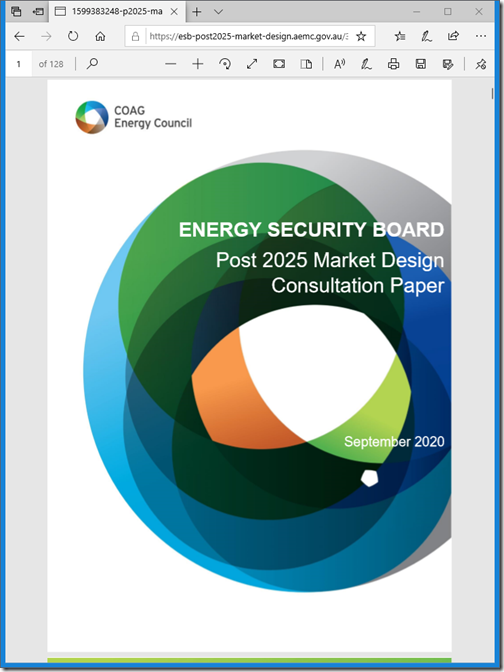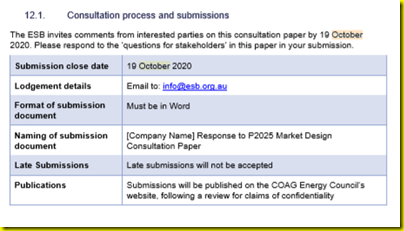On Monday 7th September 2020 (amongst the other alerts we received) we noted the release of the ESB’s ‘Post 2025 Market Design Consultation Paper’ as the next step down the road towards ‘NEM 2.0’:
As time permits, we’ll review and comment further in the weeks and months ahead – but from a quick scan of this, and related materials, the following seems to be the headline chronology:
| Date | Milestone |
| Prior |
For many years, we have been pondering the challenges inherent in this energy transition, and what it would mean in relation to the concept of ‘NEM 2.0’. 20 July 2017. I spoke about the need for a NEM 2.0 at the Clean Energy Summit in the form of this ‘Forecast, of sorts’. 5th March 2019. I posted ‘Some thoughts about Demand Response, in parallel with AEMC deliberations’ 31 May 2019. For instance, this was part of the reason why we teamed up with GVSC late 2018 and early 2019 in preparing the Generator Report Card 2018 (released on 31 May 2019). 21 Oct 2019. I posted ‘All aboard the Negawatt Express … but where are we really headed?’. |
| 25th April 2020 |
There were two papers released by COAG Energy Council as an early stage of fleshing out ‘NEM 2.0’: Paper 1 = ‘Moving to a two-sided market’ and Paper 2 = ‘System Services and Ahead Markets’. |
| Intervening |
We’ve continued to think through implications of ‘NEM 2.0’ and, in particular, would flag: 5 May 2020 we published article ‘Balancing Supply and Demand …. in the fast approaching ‘NEM 2.0’ world’ 24 July 2020 we published ‘Striving to understand the underlying challenges with Semi-Scheduled generators (re AER Issues Paper)’ On 27th July 2020 we continued that line of analysis with ‘Extrapolating from the trend of ‘Aggregated Raw Off-Target’ results, to yield some clues to what the future might hold … and one challenge for NEM 2.0’ … which has led to an expanding set of Case Studies of these extreme events. Coincidentally this morning, I’d earlier posted ‘Diving deeper (part 2), about low demands on Saturday 29th August 2020 ‘ – looking into last Saturday’s low point in demand and the challenges that were apparent there in relation to NEM 2.0. |
| Mon 7th Sept 2020 |
We noted that the AEMC published the article ‘Responding to big changes in the national electricity market’ in their news feed, which linked to the Consultation Paper. The consultation paper talks about seven workstreams: 1) Resource adequacy mechanisms (RAMs). 2) Ageing thermal generation strategy. 3) Essential system services. 4) Scheduling and ahead mechanisms. 5) Two sided markets. 6) Valuing demand flexibility and integrating DER. 7) Transmission access and the coordination of generation and transmission investment. … which have shades to these 6 enduring challenges identified by the international Association of Power Exchanges (APEx) in 1997! —– Related to this, we noted the following coverage in the various media outlets: 1) In the AFR, Angela Macdonald-Smith wrote about ‘Tougher rules on coal power closures headline revamp reforms’; 2) In the Australian, Perry Williams wrote about ‘Rules to protect electricity supply as renewables undercut coal’; and 3) In RenewEconomy, Michael Mazengarb wrote about ‘ESB puts “coal exit strategy” at centre of energy market shakeup’. 4) In the Guardian, Adam Morton wrote about ‘Australian coal plants ‘on a hiding to nothing’ and likely to close before schedule’. 5) In a quick scan this morning I did not see anything at SMH. —– Note that these publications, along with many others, are being tagged into our Asset Catalog (which has evolved from our earlier Generator Catalog, now superseded). We’re progressively opening up access for our clients there. Contact me if you’d like to access.
|
| 19th Oct 2020 |
Bizarrely a due date for submissions does not seem to be mentioned: 1) under ‘Next Steps’ in the Executive Summary of the Discussion Paper; 2) Nor is it mentioned in this note on the AEMC news site. 3) Nor could I find it on this page here. ————— Thanks to Angela’s note in the AFR above I dug and found that (on p120 of the Discussion Paper) it does ask for submissions by 19th October 2020: Maybe I missed it elsewhere but it sure does seem buried! That’s not a great start to getting the broadest range of well-considered submissions in what promises to be the largest change to the way the NEM works since it was created over 20 years ago! ———– PS 18:06 Monday – one of our readers has pointed out that the due date was referenced quite prominently on this page on the COAG Energy Council website. Unfortunately I did not come in through that route! |
| Late Dec 2020 or early 2021 |
The ESB Discussion Paper on NEM 2.0 suggests that design options will be released for consultation around late December 2020 or early 2021. |
| 2025 |
NEM 2.0 notionally starts. |
More thoughts to come!




WRT responding to ‘responding to big changes in the national electricity market’ I do hope they take this on board as one way to ease the political fallout/pushback with the need to manage the problem of rooftop solar-
https://www.solarquotes.com.au/blog/divert-solar-air-conditioning/
Of particular relevance-
‘..the timing is important as just a couple of years ago, feed-in tariffs were high and curtailment unheard of, so there was no real need to divert power to local loads. But so much household PV is now live (and more is coming), the situation has changed.
Smith said until recently, users have focused on “how much we made from export”.
“If you’re exporting, you’ve got it wrong”, he stated. “The conversation should now be how much I can consume of my own power because I’m managing it better.” ‘